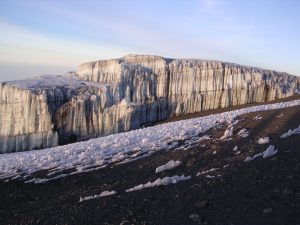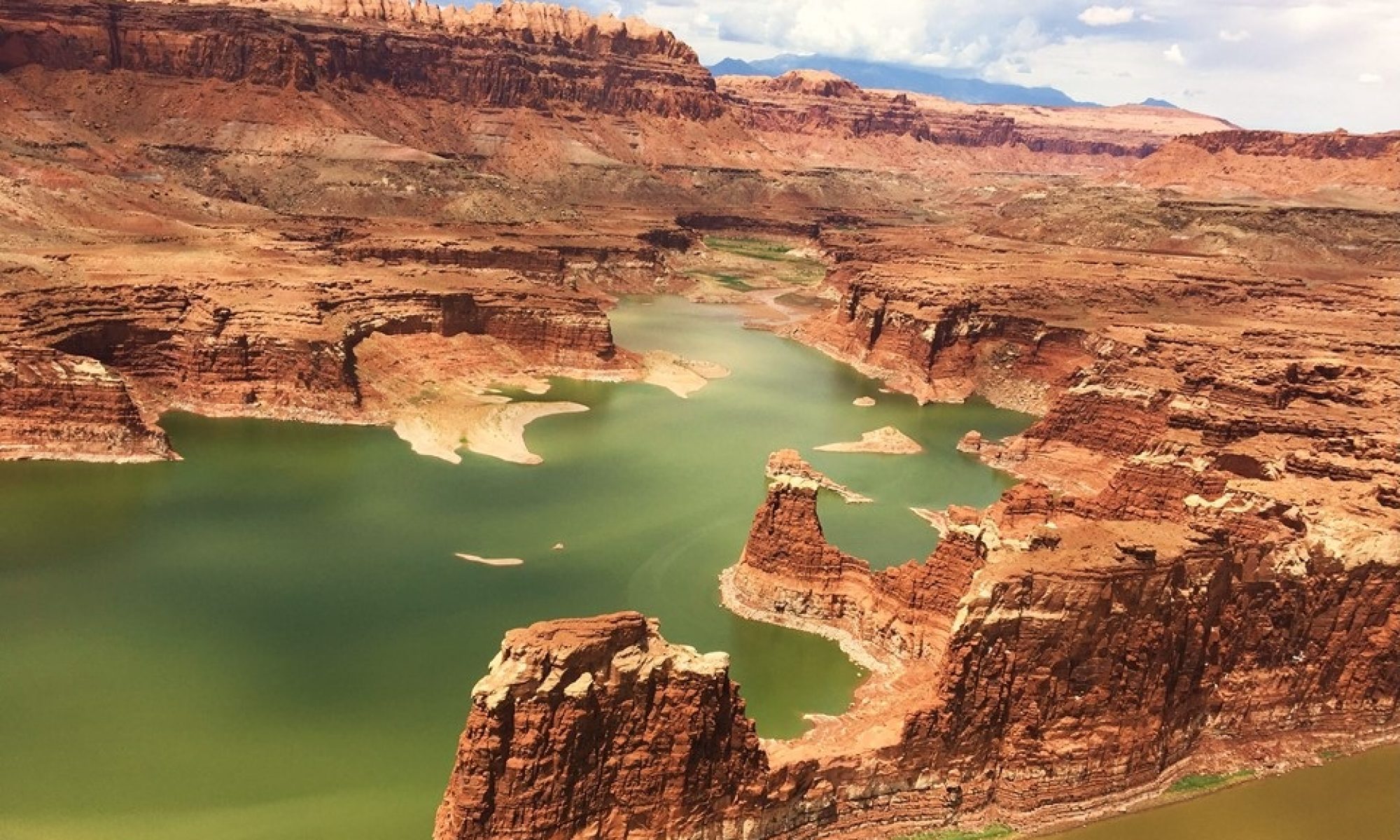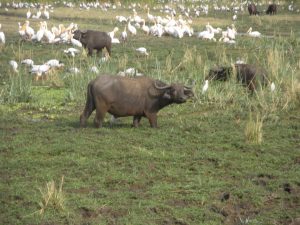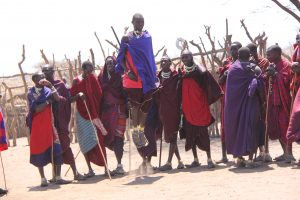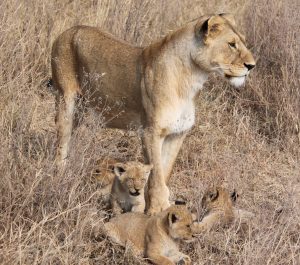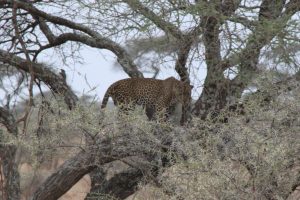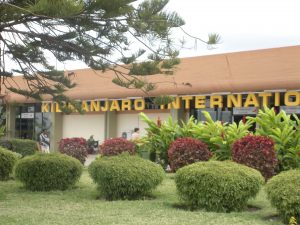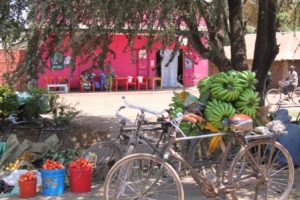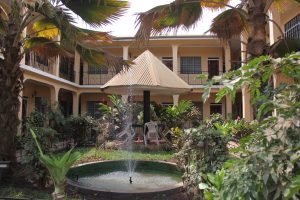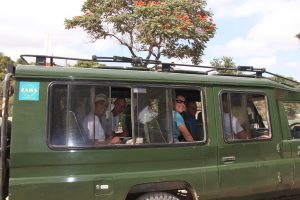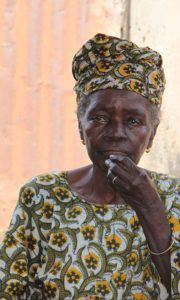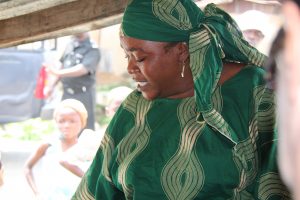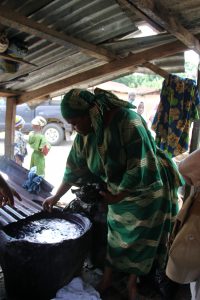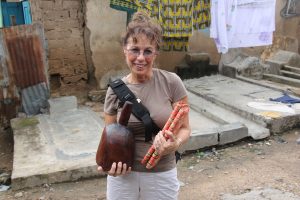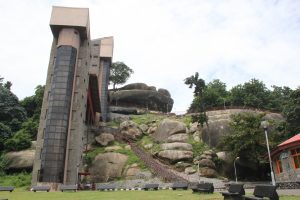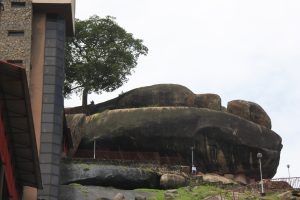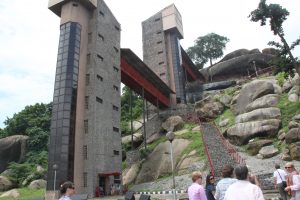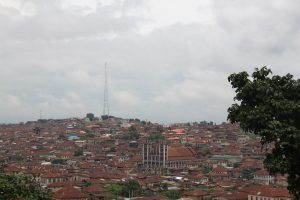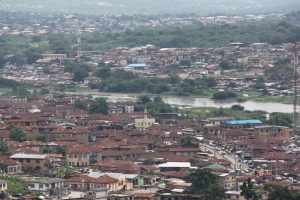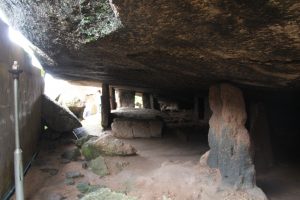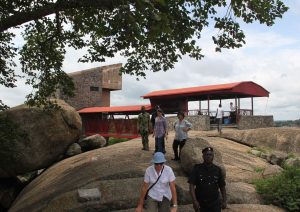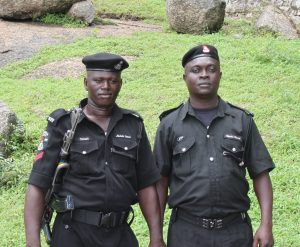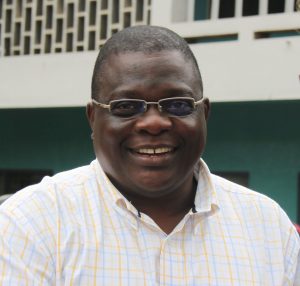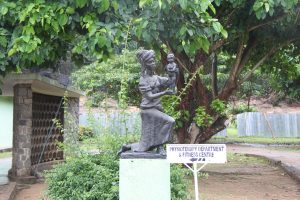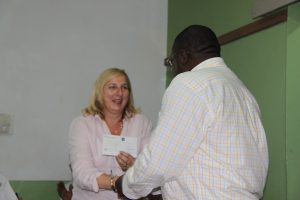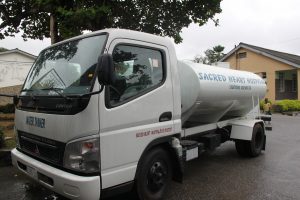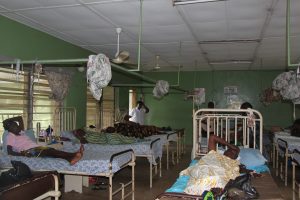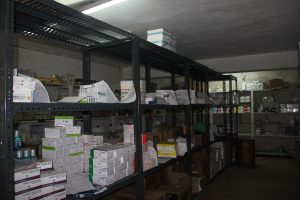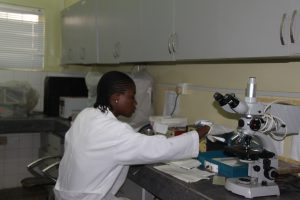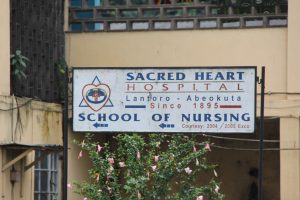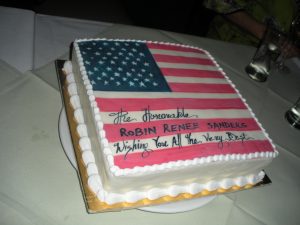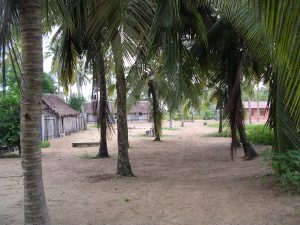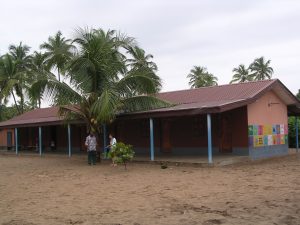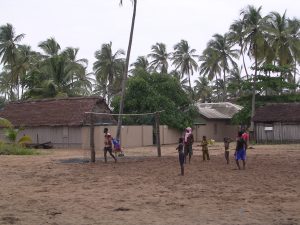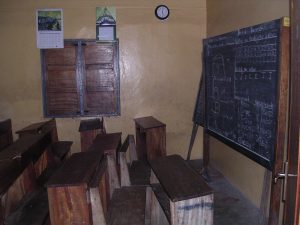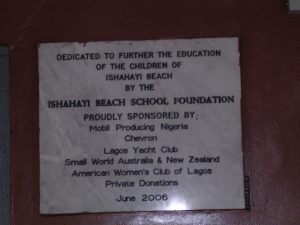Friday morning started with breakfast at the hotel and loading up the bus with the 12 of us for the 1-hour drive to the Machame Gate, (elevation ~1800m = 5910ft). As would become typical, we got off to a slow start, forgetting to turn in our room keys, and needing to stop for supplies at the local store. Cliff had the occasion to negotiate one of the best bargains this author has ever witnessed, convincing a local merchant to reduce his price from 1 Kilimanjaro hat for $7 to 10 hats for $20! Having acquired 10 new hats, Cliff then proceeded to give away 9 of these to those in the bus, including as gifts to two of our assistant guides who were accompanying us. Machame Gate (there is an actual “Gate”) was a flurry of activity with climbers arriving and registering with the Rangers, and various organization sorting out trucks full of equipment & gear, assembling and weighing loads for the porters to carry, and hundreds of guides and porters “buzzing” about, shouting instructions and readying themselves for the mountain. It was much like a scene from a movie where a “great expedition” readies itself at the far edge of civilization, preparing to embark into the great unknown. Our box lunches are distributed to us, and everyone makes their final, personal preparations and nervously awaits our start. At 11:45AM, we are excited to finally begin our ascent; initially a relatively easy hike on an old gravel, which then grades into a dirt, jeep-trail, and finally after an hour or so, turns into a maintained hiking trail. We continue hiking 2-abreast, talking and joking much of the way, conversing with other climbers who are also on this ascent-only trail. As we penetrate the rain forest, a slow drizzle begins to fall and the trail steepens, causing most of us to break a good sweat. We are amazed by the steady stream of porters that rapidly pass us carrying large tote bags on their heads and traveling almost at a run. After ~2 ½ hours, we stop along the trail for lunch, sitting on fallen trees, enduring the rain, and picking through our box lunches. A group of climbers from Glascow join us for lunch and we make acquaintance, as we will cross paths with them numerous times during this journey. After a 45 minute break, we set off again. By now, the trail has turned to dirt and stones, with many tree roots to step and climb over. The rain, heat and steepness of the trail tires everyone, but at about 5:30pm (a hike of ~15km = 9.4mi) we reach Machame Hut, (elevation 2980m = 9780ft); a campground within the edge of the rain forest. After registering with the camp’s Ranger, we locate our tents, which are already here and fully set up, although our porters left the gate well after we did. Our group of 12 climbers is supported by a staff of 43 locals, including: 1 Head Guide, 4 Assistant Guides, 2 Cooks, and 36 porters, including 2 who specifically take care of the two portable bathroom facilities that they have brought with us. Our Outfitters, “Zara” Expeditions, has provided us not only with 7 personal sleeping tents with ground cloths and sleeping mats, but also with Men’s and Women’s portable toilets, each with their own outhouse tent, and a 12 person dining tent, complete with tables, chairs and china to drink from, and metal camp gear to eat with. After cleaning up, we assemble at the dining tent for the daily, pre-dinner tea hour, complete with popcorn. Dinner is a wonderful combination of cucumber soup, boiled potatoes with cooked cabbage, a vegetable curry sauce and deep fried fish. We desert on fresh fruit and Bruce begins his daily after-dinner round-table status of every person to check on everyone’s condition, and to brief us on the next day. Everyone is doing well except Michael – who feels weak, Gabriel – who has a slight headache, and Nikki – who is having digestive problems. At this point, Bruce suggest a change of plans for Day 3 where instead of day hiking from Shira Camp, we actually hike and stay a night Moir Camp. This will also allow us to acclimate at a higher altitude before we actually summit. Everyone agrees that this is a good plan, but there is some apprehension and conditional acceptance pending on how we do tomorrow. I suspect that Bruce and our guides are unsure of our group’s ability to successfully deal with altitude and are proposing this not only to better acclimate us, but also as an early test of how we might do at Kosovo and the night of our summit ascent. We go to bed, exhausted, at ~9:00PM, and experience our first night of cold weather (4 deg C = 39 deg F). That night, many of our group who have begun taking Diamox, make regular visits to the bushes & toilet tents. However, Michael comes down seriously ill with recurring vomiting and severe diarrhea throughout the night. Imodium, Pepcid, and other over-the-counter medications do not seem to help, and Mike is weak and exhausted as we arise at 7:00am for a breakfast or porridge, Spanish omelets and toast.
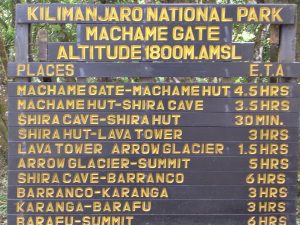
It is Saturday morning, and Bruce and many others on the Team are seriously worried about Mike as he has obviously caught some kind of “bug”, and given we are not at any significant altitude, yet, this does not bode well for him. Today’s climb will be a steep and difficult one from Machame Hut to the Shira Camp on the Shira Plateau, an ascent of over 800m and there are concerns that Mike will not be able to make it and our Group may lose its first member! With the help of Bruce and the Assistant Guides, Fort (short for Fortunato) & George, who carry Mike’s day pack, and various other members of our group who carry Mike’s water and clothes, he forces himself to continue. We begin the day’s hike to Shira at 8:45am and complete the climb 400m up during the first 4 hours to our get to our lunch spot. By this time, we have left the rain forest behind, and have crossed into the moorland zone, which is characterized by sparse vegetation and giant senecias, a type of cactus-looking plant. It has been a difficult hike, and Michael, who has hardly eaten all day, has tried to keep hydrated, but is now feverish. He is put on a steady diet of Advil, but can barely keep up with the group and is often balancing on his poles. In addition, Nikki is overheated, exhausted and frustrated that we have not arrived, yet. However, in spite of all of this, we ascend a steep wall and are greeted for lunch with a beckoning vision of our dining tent! There, we take a well-deserved hour’s break to rest and feast on carrot soup, toasted cheese sandwiches and a box of juice. After lunch, with renewed enery and determination, we continue our climb up some very steep ascents and long traverses to the Shira Plateau. However, by now, Michael has taken a turn for the worse, suffering continuous bouts of nausea and diarrhea along the trail. Progress is slow, and the rain strikes once again as we crest the final ridge at ~3:30pm and Shira Camp, (elevation ~3840m = 12,600ft), finally comes into view. We have hiked ~9km = 5.6mi today, but it was steep and difficult. We locate our personal bags, enter our tents and begin to clean up from the day’s long journey. Today’s tea hour surprises us with popcorn and deep fried chicken wings that are not very meaty, but are a welcomed delight, and we snack greedily while Michael rests. At dinner, we have our obligatory soup, (every day’s soup is Peter’s “favorite”), with rice, fried chicken and vegetable gravy, and Bruce reviews our condition and briefs us on the next day. At this point, he recommends that Michael start taking Cipro, an strong antibiotic that will hopefully improve his condition, as he is very, very weak. Luckily, Peter has some spare tablets, (6 tablets over 3 days) that he can take. Bruce also suggests that instead of proceeding to Moir Camp, we hike a shorter distance and stay tomorrow night at Lava Tower, instead. This will allow us to hike even higher the next day to Arrow Glacier, and will help in getting us prepared for the altitude without wearing us out hiking long distances. We all agree to decide in the morning on whether we are capable to going to Lava Tower tomorrow, or whether we will stay at Shira Camp. That night, the stars are aglow and the Milky Way is so close one would think you could sweep the stars away with your extended hand. We all gather to try to take pictures of the night sky, and then hunker down in our tents as the temperature drops to 0 deg C = freezing.

Sunday morning we wake to frost on the ground, condensation on the tents, and hot tea in China cups brought to our tents! As we exit our tents and head to breakfast, a beautiful sunrise occurs from over Kibo Peak. Michael has had a full night sleep and feels much better, but is still weak having not eaten in over a day. With a good night’s rest behind us and the golden glow of the morning, we all agree to head to Lava Tower today. Mike carries his own pack today, although the weight of drinking water is born for him by others. His sickness is gone, but he must stop to eat crackers and toast all along the 5-hour climb to replenish energy to continue. Meanwhile, Cliff has taken to stopping to urinate frequently, blaming it as a side-effect of the altitude medication. After a 5-hour hike that is not quite as strenuous as yesterday, we reach Lava Tower Camp, (elevation ~4630m = 15,190ft). Lava Tower is a vertical lava flow that emerged through a fissure on a ridge between two valleys, and it stands ~150ft vertically, protecting us from the wind, at the foot of our tents. We are the only ones there at this camp, and the late lunch is ready for us very soon. The soup today is vegetable, and we are surprised by delicious empanadas, chocolate wafer biscuits, tea and juice. Michael hoards the left-over empanadas for snacks tomorrow, and after lunch, it is clear that at this altitude, many are starting to show signs of acclimatization difficulties. Laurens, Helena, Gabriel, Peter and Carlos are all suffering from some form of headaches now, and it is at this point that everyone except Michelle is either on Diamox, or begins to take Diamox to relieve some of their symptoms. Helena suffers a bout of nausea, vomiting and slight dizziness, which gratefully disappears later in the day. While some rest in their tents this afternoon, Michelle and Gabriel “boulder” their way up Lava Tower, while others gather in the Dining Tent for a spirited card game of “hearts”. Michael is finally recovering from his illness and he begins to sketch again, and by dinner, everyone has settled into a comfortable, but fragile, feeling of well-being. Dinner at 7:00pm was soup with pasta covered with a type of beef stroganoff, with fruit for dessert. Bruce arrives in the dining tent at dessert, and begins the daily individual medical debrief. He recommends that everyone be on Diamox, and everyone complies except Michelle, who has had no AMS symptoms, yet. However, overall, the group is faring well, with no serious problems, and a strong Team motivation to continue and to help each other. Bruce is impressed, and we decide to tackle a climb to Arrow Glacier tomorrow, before descending to Barranco Camp. That night, the skies are clear, the wind is still and the Milky Way shines like a belt of diamonds sparking above our heads. This night, the temperature drops to -10 deg C or ~15 deg F and everyone struggles a bit with our coldest weather, yet.
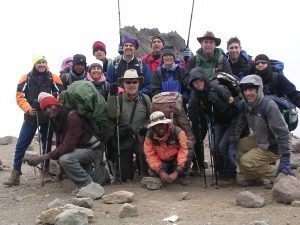
It is Monday morning and we again wake to hot tea served at our tents, assemble for our traditional breakfast of porridge, toast, omelets, sausages and hot tea, and ready ourselves for what we expect will be a cold, dusty hike. We leave Lava Tower at 9:45am and climb 2 hours to Arrow Glacier Camp, a hike through barren, dusty rock and skree to a deserted, flat spot that used to serve as an Eastern Access point to the crater rim. Here we are at 4980m = 16,340ft in altitude, and are only about a 6-hour difficult hike from the summit! However, we will take this climb as an experience for what the ascent will be like in a few days time. Everyone in the group is feeling well, excited and strong, and our guides are clearly impressed with this accomplishment. It is at this point that everyone’s confidence in successfully tackling the summit rises, and after a few Team pictures and some snacks, we begin our climb down to Barranco Camp, (elevation ~3950m = 12,960ft). We arrive at Barranco Camp at ~2:30pm after a descent of nearly 1000m. The camp is located in a valley below the Western Breach and Great Barranco Breach Wall and we quickly clean up for another late lunch. After lunch, most people nap, draw and watch as the sun disappears over the Shira Plateau. It is a spectacular view of orange and gold as the setting sun highlights the walls of the Western Breach that will be our target to ascend tomorrow. After dinner, everyone is doing well and our staff treat us to introductions and entertainment. All 40+ of them gather, sing songs of conquering the mountain and dance for us, calling us in to join them celebrating the past day’s accomplishments. We are such a novelty, that many of the other groups in camp come to see what was going on, and take pictures. Bruce personally introduced each staff member to us, we shook hands and gave hugs (Peter’s special recognition to the cooks), and then we settled down to marvel at the night glow from the ice sheets on the great mountain looming above us. We climbed into bed knowing another night below freezing was in store, but we were now secure in our knowledge that “we could do this”!
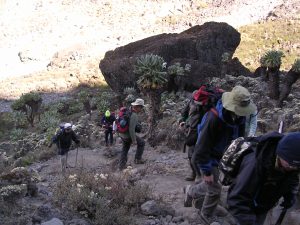
It is Tuesday morning, and we rise for tea and breakfast, and to prepare for the scramble up the Great Barranco Breach Wall. After breakfast, another group of Scotsman emerge for their journey to Barafu camp wearing silly costumes, including an excellent Spiderman outfit and a broad assortment of wigs, wings and silly dresses. It is a short hike to the “Wall” where we put away our poles and adjust our gear to prepare to use hands and feet to climb up a 100-meter near-vertical rock face. The wall is steep, but hugging the wall with sheer drops below is spaced out by having to wait in some sections where only one person at a time can possibly pass. It is amazing to watch as the porters – mgumi (singular) or wagumi (plural) – accomplish this feat without poles while carrying their own packs and balancing huge bags on their shoulders & heads, often while wearing “Jordan” basketball shoes. Most deal with the “heights” well, but Michelle has some issues and cannot stand to have anyone too near to her while in this precarious position. In 90 minutes, we finally get to the top and have a great view of the Kibo massif and the Heim Glacier looming above us. When we look back, we can see the Barranco Valley and camp site that was our previous night’s stay. From here, we hike for another 4 hours, crossing numerous valleys and ridges, some of then best described as “moonscapes” – eroded fields of rock and dust without a sign of living things. We finally descend into Karanga Valley and reach our camp, (elevation ~4100m = 13,450ft), by ~2:30pm – another day of a late lunch. This day’s lunch includes a thick bean sauce over rice that tasted great, but soon gives many of the team a bloated feeling and a bad case of indigestion and gas. After lunch, those who are feeling up for it again engage in another card game of “hearts” while Michael draws caricatures of all the players. Today was fun and an excellent day for recuperation in preparation for our ultimate ascent. However, the lunch and consequent indigestion has many people upset and worried about their condition tomorrow. After dinner, Bruce instructs us on the details of our coming day, which will include a hike to Barafu camp, and hopefully on to Kosovo camp where we will rest until 11:30pm to begin our ascent to the summit. We go to bed early knowing sleep again will be a long way off.
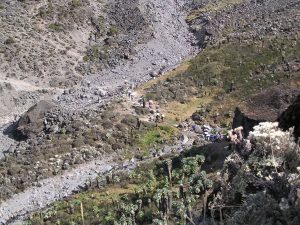
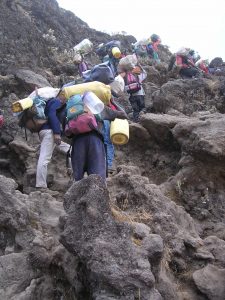
Wednesday morning begins with the usual routine, however, today Carlos has come down ill with serious digestive problems and diarrhea. This is a worrisome development coming less than 24 hours before we begin our ascent. Bruce provides various digestive medications, and then leaves early to go ahead to talk with the Ranger at Barafu camp about getting permission to stay at Kosovo. Assistant guides, George, Fort and Adam are our leads today, as we start the 5 ½ hour ascent to Kosovo. Kosovo camp is located one hour further up the trail past Barafu, and will save us two hours of climbing and hiking in the night in reaching the summit. This is a strategic move to shorten the journey and we have prepared for the extra time at this higher altitude with our excursions to Lava Tower and Arrow Glacier. As we pass through Barafu Camp, we sign in with the Ranger and learn that Bruce has successfully secured us permission to continue on. Barafu Camp is like a frontier mining town, with people camped willy-nilly everywhere. Groups of dirty hikers are arriving and leaving from all directions and there is a sort of “wild” atmosphere around the camp. Here, the dust in your mouth and the smell of sweat and urine in your nose characterize a place where everyone is transient and focused on getting somewhere else. We gladly exit Barafu Camp, immediately climb a small wall, and hike about one hour to the Kosovo camp – a small flat place along the trail where we camp just by ourselves and prepare to ascend. Carlos is doing better, but he must build up some energy to make the climb to the summit. We eat a 3:00pm lunch and rest/nap until 7:00pm, when we get up, have dinner and receive our final briefing. Carlos is now doing much better, and after the briefing, we are all back off to bed to rest, and be awaken at 11:30pm. As we rise, it is already below freezing, and the temperature will drop as we ascend in altitude.
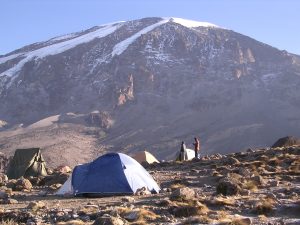
We begin our ascent at 12:20am on Thursday, September 9th in the dark. We are led by Fort, with Adam, George and Bruce distributed among our group. The rest of the support team will remain in camp and, hopefully, welcome our triumphant return later. Progress is initially slow but steady as the trail steepens immediately and we try to keep moving to keep from getting cold. We stop for water and snacks every 45 – 60 minutes, and given we are currently the 1st on the mountain this night, we have a wonderful clear night view of those following us. Looking back down the mountain at night is a string of headlamps, snaking their way along in the dark, resembling a candle-light pilgrimage reminiscent of scenes from the movie “Conan the Barbarian”. Are steady pace and hourly stops allow some faster-paced hikers to pass us, but we are all together and doing well in our ascent. Every 10 minutes or so, our guides either break out in song, or call for a “Yah” or “Kili” shout from the Team and our spirits are kept high. Finally, at 5:50am, we reach Stella Point at the rim of the crater, (elevation ~5685m = 18,650ft). It is still dark, but in the predawn light, we can see others joining us from different routes that finally coalesce here. Just beyond Stella Point, we stop briefly and are surprised by our guides as they break out a dozen china tea cups and thermoses of hot tea, obviously carried up the entire ascent for our benefit. At this point, we take a reading on the temperature, and it is -15 deg C = ~4 deg F – much colder with the wind chill! From Stella Point we could see the colored sky announcing the impending sunrise. And then, all together we begin the last ascent to Uhuru Peak – the Top of Africa! Along the way, the sun rises, lifting our spirits and the temperature. To our right is the crater floor, and to our left shimmering in the emerging light are the remnants of the summit glaciers. We reach Uhuru Peak at 6:40am, (elevation ~5895m = 19,340ft) where we take time for hugs & congratulations and various team pictures. All 12 of us have made it – “The Simba Team” – and we’ve done it together. Along the way there were personal physical & mental challenges that everyone needed to overcome, and these were successfully tackled by all. We begin the long descent down at ~7:00am in the daylight, each person picking their own comfortable pace and route down the loose skree. Everyone is tired, but Sue, Cliff and Carlos are particularly struggling with the downhill pounding on their knees. We arrive back at our Kosovo camp between 9:30am and 10:30am to the hardy congratulations of our support team. We can get a brief rest until 11:00am, but then it is time to pack up the camp, eat lunch and set off on an epic journey to Mweka Camp, a further descent of over 1500m = 4920 feet! We leave camp at 12:30pm knowing we face a 6-hour journey down. Where our stay at Kosovo shortened our ascent, it has now lengthened our journey down, and we all settle in for a long, grueling hike. We pass through Barafu camp again, and then descend through the varied ecosystems to transverse the Moorlands and re-enter the rain forest. Along the way, we pass through “Millenium” camp, a trading outpost that has been in place since the year 1900, where bootleg beer and Coca Colas can be had by celebrating hiker for the right price. Many people are tired and/or hurting on this leg of the journey. Nikki is struggling until she has her first Coco Cola in a week, and then she, Laurens and Helena strike out into the lead. Gabriel, Michael, Rocky and Peter trail along 10-15 minutes behind, Guy & Sue following, and Carlos and Cliff assisted by Michelle rounding up the group. We all reach Mweka camp between 6:30 and 7:15pm, as the sun is setting. Everyone signs in at the Ranger station, settles into their tents, wash and immediately head to dinner. Bruce rewards everyone with congratulations and a well deserved Kilimanjaro beer, and after dinner, the exhausted group goes to bed before 9:00pm.
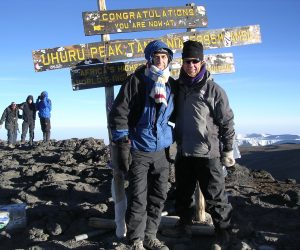
On Friday morning, we arise early with our compulsory morning tent tea and have an early breakfast at 7:00am. After breakfast, we have one final get together with the entire Support Team where we take pictures, sing songs and dance together celebrating the mountain and our accomplishments. There are handshakes and hugs all around, and we are humbled by the intensity of the bond that has formed between the staff and ourselves as we say our last “goodbyes” to many of them who will go ahead to finish their trip and reconnect with their families. We set off for a final 3-4 hour hike to Mweka Gate to meet our first transport other than our feet for over a week. The trail continues it’s steep descent until it finally turns into a rutted rescue road, traversing local villages and communities along the way. The people who live there are harvesting crops as their young children beg for chocolate or any other handout – a sign of “tourism” that disappoints us. Everyone reached the gate between 11:00am and noon, signs the official Park Registry recording our official moment of peak ascent, and then we board a bus with our gear on the roof to return to Springlands Hotel, arriving back at ~1:00pm. Back at the Hotel, most prepare for a long-awaited shower while we sort out the final details of insuring that appropriate tips are paid to the Guides, Cooks and Porters. Many on our group donate unneeded equipment and unused medications. The presentation of certificates will take place later this evening. After cleaning up and taking lunch at the hotel, many of the group assemble for a final lively game of cards in the outdoor courtyard while the wine and beer flow freely.
The other members of our group are supposed to arrive from Zanzibar at 7:00pm, but they are delayed 90 minutes in Dar es Salaam. Meanwhile Bruce and the assistant guides and cooks were supposed to meet us for certificate presentations at 7:00pm, but they actually arrive at 8:00pm, and only after checking names are they prepared to present. Therefore, the Zanzibar group arrives as the presentations are going on and got to participate in the story-telling and evening’s festivities. The partying continues late into the night, and after confirming everyone’s transport for tomorrow, it was off to the room to pack and sleep as everyone sets off for home. As we depart over the next day, everyone expresses the fact that was truly “an adventure of a lifetime”.
